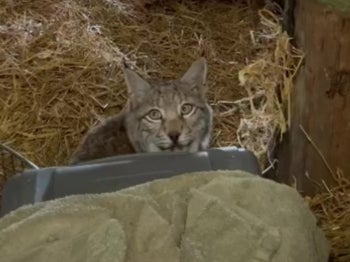The wild animals next door: Interactive map reveals where 2,700 dangerous exotic pets are being kept in the UK - as four lynx are captured in the Cairngorms
Share:
The UK might not be known for its exotic wildlife. But you could be unknowingly living next door to one of the dangerous wild animals which are legally owned by private enthusiasts all around the country. Data shows that more than 2,700 exotic pets ranging from venomous snakes and scorpions to lions and cheetahs are being kept in Britain.
![[Thanks to a piece of legislation called the Dangerous Wild Animals Act, it is legal to own almost any animal so long as you can prove it can't escape. That includes members of the lynx family like the Eurasian lynx found in the Cairngorms (pictured) and bobcats]](https://i.dailymail.co.uk/1s/2025/01/17/16/94215171-14293303-image-m-2_1737131320457.jpg)
Now, as semi-tame lynx are captured roaming in the Cairngorms, experts have raised concerns that Britain's hidden zoos could be putting animals and humans at risk. Earlier this month, two separate pairs of lynx were released near the town of Kingussie, in the Cairngorms National Park.
![[On January 9, a pair of Eurasian lynx were found in the Cairngorms National Park. Days later, a second pair were found in a nearby area. Blame was initially placed on 'rogue rewilders']](https://i.dailymail.co.uk/1s/2025/01/17/16/94217125-14293303-image-a-17_1737129619524.jpg)
While the finger was initially pointed at 'rogue rewilders', suspicions have now been raised that the lynx could have been released by a private owner. There are no lynxes legally owned in Scotland, but they might have been owned illegally as part of the UK's exotic pet black market prior to their release.
![[The Eurasian lynx (pictured) is a medium-sized wildcat which is native to Northern Europe and Central Asia. These predators once lived in Britain but were driven to extinction about 1,300 years ago]](https://i.dailymail.co.uk/1s/2025/01/17/15/94215343-14293303-image-a-7_1737127490107.jpg)
Chris Lewis, captivity researcher at animal charity Born Free, told MailOnline: 'It does suggest that someone was potentially keeping them illegally and no longer wanted them.'. As semi-tame lynx are found roaming in the Scottish Highlands, experts have raised concerns that the number of privately owned exotic pets in the UK could be putting animals and their owners at risk.
![[The rogue lynx were captured by the Royal Zoological Society of Scotland who said that they were semi-tame and unable to catch their own food]](https://i.dailymail.co.uk/1s/2025/01/17/15/94215151-14293303-image-a-8_1737127503054.jpg)





















